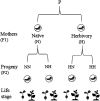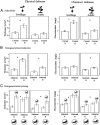Phenotypic plasticity in plant defense across life stages: Inducibility, transgenerational induction, and transgenerational priming in wild radish
- PMID: 34389664
- PMCID: PMC8379918
- DOI: 10.1073/pnas.2005865118
Phenotypic plasticity in plant defense across life stages: Inducibility, transgenerational induction, and transgenerational priming in wild radish
Erratum in
-
Correction for Sobral et al., Phenotypic plasticity in plant defense across life stages: Inducibility, transgenerational induction, and transgenerational priming in wild radish.Proc Natl Acad Sci U S A. 2023 Aug 15;120(33):e2311866120. doi: 10.1073/pnas.2311866120. Epub 2023 Aug 7. Proc Natl Acad Sci U S A. 2023. PMID: 37549302 Free PMC article. No abstract available.
Abstract
As they develop, many plants deploy shifts in antiherbivore defense allocation due to changing costs and benefits of their defensive traits. Plant defenses are known to be primed or directly induced by herbivore damage within generations and across generations by long-lasting epigenetic mechanisms. However, little is known about the differences between life stages of epigenetically inducible defensive traits across generations. To help fill this knowledge gap, we conducted a multigenerational experiment to determine whether defense induction in wild radish plants was reflected in chromatin modifications (DNA methylation); we then examined differences between seedlings and reproductive plants in current and transgenerational plasticity in chemical (glucosinolates) and physical (trichomes) defenses in this species. Herbivory triggered genome methylation both in targeted plants and their offspring. Within one generation, both defenses were highly inducible at the seedling stage, but only chemical defenses were inducible in reproductive plants. Across generations, herbivory experienced by mother plants caused strong direct induction of physical defenses in their progeny, with effects lasting from seedling to reproductive stages. For chemical defenses, however, this transgenerational induction was evident only in adults. Transgenerational priming was observed in physical and chemical defenses, particularly in adult plants. Our results show that transgenerational plasticity in plant defenses in response to herbivore offense differs for physical and chemical defense and changes across plant life stages.
Keywords: ecology; epigenetics; evolution; herbivory.
Conflict of interest statement
The authors declare no competing interest.
Figures



Similar articles
-
Adverse effects of inbreeding on the transgenerational expression of herbivore-induced defense traits in Solanum carolinense.PLoS One. 2022 Oct 25;17(10):e0274920. doi: 10.1371/journal.pone.0274920. eCollection 2022. PLoS One. 2022. PMID: 36282832 Free PMC article.
-
Ecological genetics of an induced plant defense against herbivores: additive genetic variance and costs of phenotypic plasticity.Evolution. 2002 Nov;56(11):2206-13. doi: 10.1111/j.0014-3820.2002.tb00145.x. Evolution. 2002. PMID: 12487351
-
Transgenerational defense induction and epigenetic inheritance in plants.Trends Ecol Evol. 2012 Nov;27(11):618-26. doi: 10.1016/j.tree.2012.07.011. Epub 2012 Aug 31. Trends Ecol Evol. 2012. PMID: 22940222 Review.
-
Small but strong: herbivory by sap-feeding insect reduces plant progeny growth but enhances direct and indirect anti-herbivore defenses.Oecologia. 2024 May;205(1):191-201. doi: 10.1007/s00442-024-05567-2. Epub 2024 May 23. Oecologia. 2024. PMID: 38782789
-
Priming of antiherbivore defensive responses in plants.Insect Sci. 2013 Jun;20(3):273-85. doi: 10.1111/j.1744-7917.2012.01584.x. Epub 2012 Dec 19. Insect Sci. 2013. PMID: 23955880 Review.
Cited by
-
Differential environmental and genomic architectures shape the natural diversity for trichome patterning and morphology in different Arabidopsis organs.Plant Cell Environ. 2022 Oct;45(10):3018-3035. doi: 10.1111/pce.14308. Epub 2022 Mar 27. Plant Cell Environ. 2022. PMID: 35289421 Free PMC article.
-
Plant environmental memory: implications, mechanisms and opportunities for plant scientists and beyond.AoB Plants. 2023 Jun 6;15(4):plad032. doi: 10.1093/aobpla/plad032. eCollection 2023 Jul. AoB Plants. 2023. PMID: 37415723 Free PMC article. Review.
-
Enhancing Conservation Efforts in the Qinling Mountains Through Phenotypic Trait Diversity Optimization.Plants (Basel). 2025 Jul 10;14(14):2130. doi: 10.3390/plants14142130. Plants (Basel). 2025. PMID: 40733367 Free PMC article.
-
Molecular basis of phenotypic plasticity in a marine ciliate.ISME J. 2024 Jan 8;18(1):wrae136. doi: 10.1093/ismejo/wrae136. ISME J. 2024. PMID: 39018220 Free PMC article.
-
Tolerance Mitigates Gall Effects When Susceptible Plants Fail to Elicit Induced Defense.Plants (Basel). 2024 May 26;13(11):1472. doi: 10.3390/plants13111472. Plants (Basel). 2024. PMID: 38891281 Free PMC article.
References
-
- Agrawal A. A., Induced responses to herbivory and increased plant performance. Science 279, 1201–1202 (1998). - PubMed
-
- Karban R., The ecology and evolution of induced resistance against herbivores. Funct. Ecol. 25, 339–347 (2011).
-
- Verhoeven K. J., vonHoldt B. M., Sork V. L., Epigenetics in ecology and evolution: What we know and what we need to know. Mol. Ecol. 25, 1631–1638 (2016). - PubMed
-
- Jablonka E., Raz G., Transgenerational epigenetic inheritance: Prevalence, mechanisms, and implications for the study of heredity and evolution. Q. Rev. Biol. 84, 131–176 (2009). - PubMed
-
- Bossdorf O., Arcuri D., Richards C. L., Pigliucci M., Experimental alteration of DNA methylation affects the phenotypic plasticity of ecologically relevant traits in Arabidopsis thaliana. Evol. Ecol. 24, 541–553 (2010).
Publication types
MeSH terms
Substances
LinkOut - more resources
Full Text Sources
Research Materials
Miscellaneous

